@winewhiskywatches On His Insane Sapphire Armin Strom Resonance Masterpiece 1
Indeed, these watches are really there, into the wild!
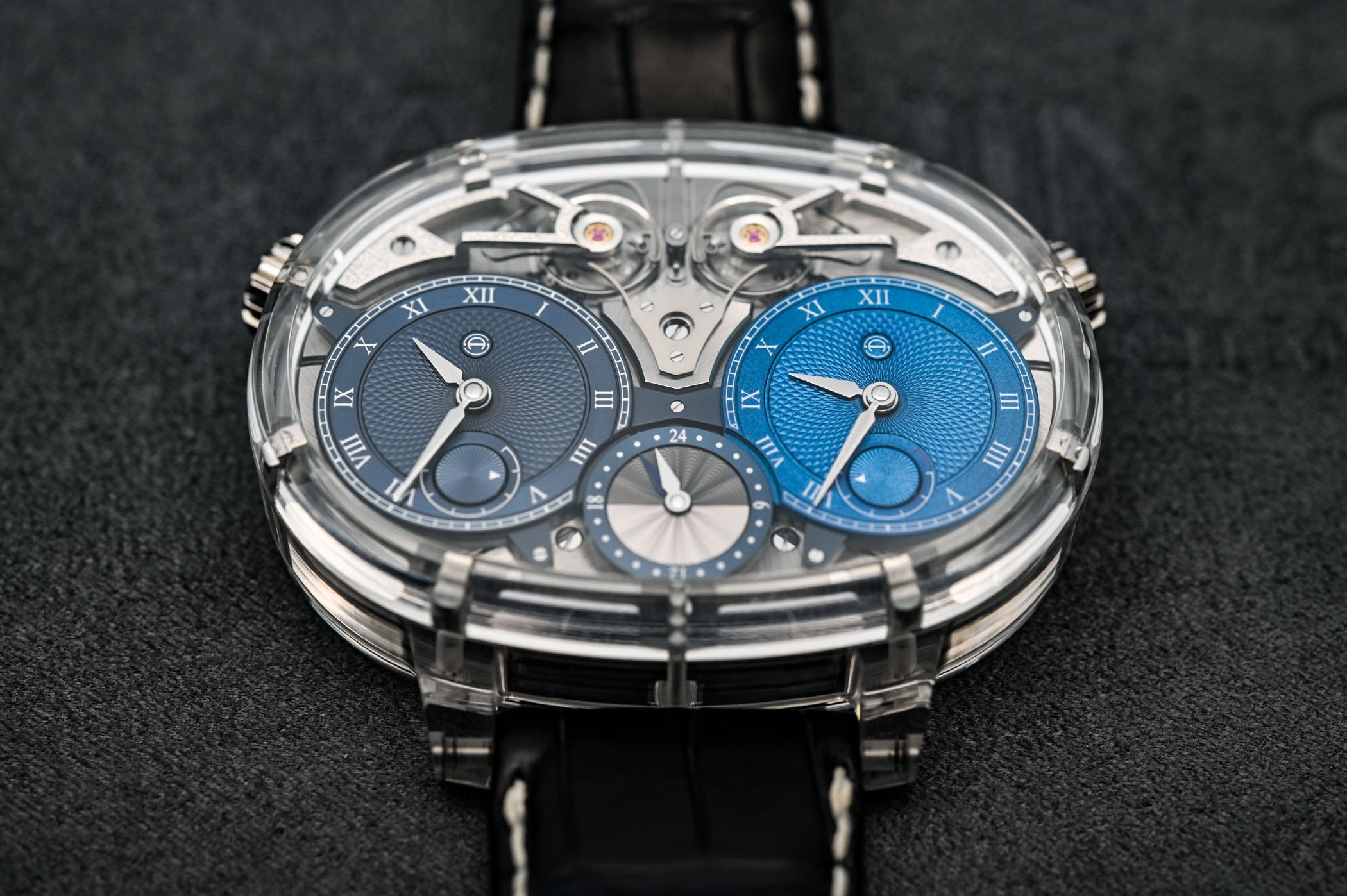
Ever wonder who actually owns a watch like this? One collector, who is a friend with a passion for independent watchmaking, actually does. He prefers to remain anonymous for the safety of himself and his family, but he goes by @winewhiskywatches on Instagram. This will be our second interview about an Armin Strom timepiece in his collection (the first one being about his Mirrored Force Resonance), and altogether the fifth time this seasoned collector participates in such an interview with us… And yes, this totally insane Armin Strom Sapphire-Cased Dual-Time Resonance a.k.a Masterpiece 1 is a watch that he wears on a regular basis.
Frank Geelen, MONOCHROME – What led you to acquire another Armin Strom watch?
@winewhiskywatches – My first one exceeded my expectations and it quickly became my go-to daily watch. My interactions with Serge Michel and Claude Greisler, co-founders of the brand’s current incarnation, were also particularly positive. So much so that I found myself motivated to dive in deeper. The watch we’re talking about today was actually my third Armin Strom timepiece. My second was a ‘unique piece’ tourbillon that I had commissioned; which I’m also particularly fond of. While all of my Armin Strom watches share some design DNA, they’re nevertheless so distinctly different from one another that they easily co-exist in my collection.
As an early supporter, I’ve enjoyed watching Armin Strom mature as a brand. They still operate somewhat under the radar, but that seems to be changing. What’s your perspective on that?
Based on the watches that they’ve released since 2016, their ascension as an independent brand seems somewhat overdue. Their aesthetic creativity, horological inventiveness and hand-finishing have all levelled up since their integrated Manufacture’s completion. I think that you can also see their progress in brand maturity reflected in the steady increase in resale values for those pieces in the secondary market.
Why this Dual-Time Resonance a.k.a The Masterpiece 1?
When I saw the Masterpiece 1 for the first time, I was immediately intrigued by the watch’s unconventional aesthetic design and horological ambition – but first and foremost, I loved the watch. It’s a bold master class on the wrist; encompassing pioneering movement design, exceptional hand-finishing and a synchronized kinetic spectacle that’s unlike anything else. Moreover, the milestone goal of leveraging the Resonance phenomenon with absolute consistency is fully realized here. It doesn’t have a Resonance “reset” pusher because it doesn’t need one. Its two movements sit side by side instead of being vertically stacked; further distinguishing it in the very limited history of resonance movements. Its meticulous hand-finishing became even more impressive when viewed with a loupe. While legibility and timekeeping are always important, a watch like this is probably more about inspiring a sense of awe. The ‘familiar’ is its starting point. But it’s the reinterpretation of the familiar, expressed from an unexpected aesthetic perspective – but nevertheless with an uncompromising commitment to craft – that made this watch so compelling for me.
Between the hypnotic pulsation of its clutch spring, the synchronized motion of two balance wheels operating in a state of Resonance, the Kari Voutilainen guilloché sub-dials, the exquisite hand finishing that holds up under any magnification that I can throw at it, and the exposed movement in its transparent sapphire case – there’s apparently no limit to how long this watch can sustain my attention.
You’re unlikely to ever see a watch like this emerge from a volume-driven corporate brand. The super-low volume production of Armin Strom’s Masterpiece series is probably what enables Claude Greisler to indulge in the purest expressions of his artistic and horological sensibilities – without the commercial considerations that you’d ordinarily expect to exert an influence on design. I think that sort of freedom from convention and commercial practicality is what makes independent watchmaking so compelling – at least for me.
That’s a great segue to my next question: What do you think elevates a watch from being a well-made utilitarian object into an Art Piece?
I think that an art piece has to offer a differentiated aesthetic vision and it has to have a visceral appeal that transcends fine watchmaking and horological inventiveness. From my perspective, a horological art piece is one that fully realizes a bold ambition to integrate and elevate aesthetic and mechanical concepts into objects that make you “feel” as much as they make you think.
With other iterations in rose gold, white gold and titanium, what led you to choose this iteration with a sapphire case?
The clever answer would be that putting an open-worked movement into a sapphire case made this iteration more consistent with the brand’s ‘transparent mechanics’ ethos. The more serious answer is that it was the best option to highlight this extraordinary movement’s meticulous hand-finishing – and to see it from every angle. The sapphire case also invites more light into the movement – and that’s always a plus – particularly for people like me who enjoy repeated viewings with a loupe. A related benefit is that you get more ‘pop’ from the contrast between the movement’s high-polish and satin surfaces, not to mention the tremblage finishing on the balance bridges and the blue guilloché dials. All of those elements love the light. The sapphire case also completely changes its aesthetic presentation – making it more consistent with the ‘art piece’ vibe of the watch. More abstractly, I think that the artisanal effort of having to cut, hand-finish and hand-polish a complex sapphire case actually makes it more consistent with the values of haute-horology watchmaking, particularly when the movement on display is finished to such a high standard.
From a usability perspective, sapphire is a lightweight case material that I think wears more comfortably than other case options. It also enables what is an admittedly big case to wear somewhat smaller. There’s also a strong appeal in a case material that’s unlikely to ever get scratched – absent rubbing it with a diamond.
I understand the criticism that the choice of a sapphire-cased watch is often – and probably fairly – correlated to some sort of gratuitous flex. However, I do think that’s probably much less of a factor in this watch. The brand isn’t all that widely known yet so that motivation probably wouldn’t make much sense in this context.
Does it get much wrist time?
Much more than you might think. I wear it a lot. Its unusual shape has the advantage of making it sit very comfortably on the wrist, it’s lightweight – and as I said earlier, it’s almost scratch-proof. Given the lack of concern about inadvertently scratching it, I wear it fairly regularly – at least twice a week.
The watch has four barrels representing 110 hours of power reserve: so wearing it that often means that I rarely have to even set the time. On a side note, If you wind the watch while looking at the back of the case, you get the added bonus of seeing those four mainspring barrels turn as the watch gets wound.
With so many independent and corporate brands now producing open-worked watches, how do you decide which ones to add to your collection?
With even historically-conservative brands now jumping on the open-worked bandwagon, it does feel like there’s a need for a conceptual framework to properly assess these sorts of watches. To explain mine, I have to tell you a quick story. When I first met Claude Greisler (co-founder and Master Watchmaker at Armin Strom), he articulated a passionate commitment to what he called “transparent mechanics.” I interpreted that to simply mean openworked dials. I’m generally fairly direct, so I pointed out that openworked watches were becoming fairly trendy and that most brands were now releasing those sorts of watches – so how could that possibly be a core value and brand differentiator for Armin Strom? His answer was unexpected but it made perfect sense. In his view, the only valid reasons for an open-worked watch to even exist are to either show you how it works or to showcase exceptional movement finishing. And the best open-worked watches do both. Moreover, the technical aspects and the aesthetic aspects should seem like they were conceived together – hopefully, because they were. That’s his definition of “Transparent Mechanics.” Without getting into specifics, he challenged me to think about all of the openworked watches that I’d seen released over the prior few years – and it became clear fairly quickly that the vast majority of those watches couldn’t pass his litmus test. That afternoon, many of the other openworked pieces that I’d been thinking about were suddenly reduced to being overpriced fashion watches.
What do you look for before going all-in with an Independent watch brand?
I’ll start with a distinctive aesthetic and horological sensibility; one where the technical aspects and the aesthetic aspects seem like they were conceived together – hopefully, because they were. What I appreciate most about my favourite independents is the creative integrity that clearly drives them to defy conventional wisdom in pursuit of an unconventional goal. Consider this watch as an example. The decision to develop an oversized open-worked Resonance movement in an oval shape – and then to hand-finish it to an incredibly high standard – and then to house it in an oversized sapphire case – and then to limit production to only eight pieces – clearly epitomizes the audacity of independent watchmaking. Can you even imagine any corporate brand approving the development or production of something like this? Of course, beyond the technical and artistic merits of the watches themselves, the opportunity to form a personal bond with the principals of a small independent brand really differentiates the experience of supporting independent watchmaking from the experience of owning a corporate big-brand watch.
Long-term financial viability is another concern. I hope to always have my watches serviced by the brands who produced them; especially when they contain esoteric movements like this one. So far I’ve been pretty lucky with my bets – as all of the independent brands that I’ve bought into seem to have made it past the point of worrying about that. I suppose that “buy the seller” applies as much to independent brands as it does to retailers.
Do you think that some collectors might be put off by an independent brand that doesn’t include its namesake?
I would guess so, but in the case of Armin Strom that feeling is misplaced in my opinion. Here’s why: The Armin Strom brand story is very different than it may appear on the surface and it isn’t widely understood. It was really Claude and Serge who were responsible for the brand’s design DNA, its horological innovation and its watchmaking infrastructure. Mr Armin Strom, the brand’s namesake, never actually designed or built his own watch movements – and he never built a watchmaking facility that could aspire to do so either. His speciality was watch repair and skeletonizing third-party movements – which he then cased and sold under his own brand name. But he was nevertheless a local icon in Burgdorf – the town where Serge and Claude grew up. Mr. Strom, by virtue of his international travels and flashy sports car, was also an inspiration to Claude and Serge in their childhoods. And he originated the local belief that movements were meant to be seen, not hidden away.
That belief became the inspiration for the openworked watchmaking brand that Serge and Claude ultimately hoped to build. For that reason, they were proud to build that brand under the banner of his name. And that name did have some niche brand cachet, particularly in Burgdorf and Biel. But make no mistake about it: it’s Serge and Claude who really deserve the credit for everything that they accomplished after buying the brand name. And that’s the explanation for why they both carry the ‘founder’ title. You could argue about whether it was wise to do 99% of the work while giving most of the credit to Mr. Strom, but that’s the decision they made – and they don’t seem to regret it.
Let’s shift gears and dive into a technical discussion. What’s your perspective on Armin Strom’s approach to Resonance versus other “acoustic”-oriented approaches to Resonance?
I think that Armin Strom’s Resonance movements were, at least initially, broadly misunderstood. Their approach to Resonance isn’t just another way of doing the same thing as acoustic-based Resonance movements. They represent an entirely different way of harnessing Resonance in order to accomplish entirely differentiated technical and aesthetic goals.
Fundamental to understanding the value proposition for Resonance is learning that balance wheels are typically subject to oscillation ‘beat rate’ errors attributable to motion, gravity, temperature changes and shocks – all of which can negatively impact on timekeeping. Resonance offers a compelling means to address that issue. But the key to understanding what differentiates Armin Strom’s approach from others is recognizing that acoustic-based approaches can only leverage the Resonance phenomenon to remediate beat-rate deviations, whereas the Armin Strom approach actively prevents them.
That’s because the acoustic-based approach relies on just two oscillators – two balance wheels – to regulate each other. In that paradigm, when one of them has been affected by gravity or wrist motion or temperature changes and has sped up or slowed down, the other balance wheel will gradually lure its wayward brother back to the average oscillation rate. The objective and the result is better timekeeping accuracy.
The Armin Strom approach is different-in-kind because it actually deploys a third oscillator, a patented clutch spring, to proactively prevent such oscillation-rate deviations in the first place; rather than just reactively responding to them. That’s a meaningful and significant difference from a horological perspective. Here’s why: aside from the improvement that a sustained state of Resonance offers in the context of timekeeping accuracy, proactively preventing oscillation-rate variations is a prerequisite for chronometric consistency. In simple terms, that ‘consistency’ means that you can expect to gain or lose precisely the same number of seconds every day. Achieving that objective was a serious horological ambition back in the 17th and 18th centuries – when Huygens and Breguet were obsessed with Resonance. Because, if they had succeeded, it would have changed Marine Chronometry and therefore the world as we know it. That’s because, back then, knowing the exact time at your point of origin was a critical prerequisite for a precise calculation of longitude. Inconsistent chronometers led to ships being lost at sea – and the occasional accidental discovery of new lands. But if a chronometer could actually gain or lose PRECISELY the same number of seconds EVERY day, a ship’s navigator could easily incorporate that predictable timekeeping variance into their calculations to determine their precise location. The military and economic implications would have been enormous and game-changing.
You might legitimately ask whether that consistency offers any practical benefit today; since Global Positioning Systems have made marine chronometry about as important as a Chronograph in the smartphone era. But ambitious modern watchmaking often revisits the unrealized challenges of the past to solve what once seemed unsolvable. Claude Greisler had the ambition to be the first to solve the historic chronometric consistency problem – and Resonance was his means to that end. Claude wasn’t the first to harness Resonance to improve wristwatch timekeeping accuracy – that distinction of course belongs to Francois Paul Journe. But Claude was indisputably the first to fulfil the promise of Resonance in terms of chronometric consistency. He found a solution to a 350-year-old challenge that had haunted and eluded both Huygens and Breguet, two of history’s greatest watchmakers. And I think that’s a horological milestone worthy of recognition in its own right.
As an owner of a Masterpiece 1, what’s your perspective on Armin Strom’s Masterpiece 2 – the Minute Repeater Resonance?
I think that at some level, both watches in the Masterpiece series were created as technical proofs. When the Masterpiece 1 was released without a Resonance reset pusher, I saw that as an expression of Armin Strom’s absolute confidence in their ability to maintain an uninterrupted state of Resonance. After seven months of ownership, I can confirm that a Resonance reset pusher would be pointless for this watch – it doesn’t need one. I think that the Masterpiece 2 takes that proof to an even further extreme – by again leaving out the reset pusher while combining their Resonance movement with a Minute Repeater. I love that the Masterpiece 2 exists at least in part to make the point that Armin Strom’s unique approach to maintaining a state of Resonance is so stable that it won’t even be disrupted by the striking gongs of a Minute Repeater. And it accomplishes that in a stunning aesthetic presentation that’s entirely different from the look and feel of my Masterpiece 1. I actually had the pleasure of wearing a Masterpiece 2 last year and it definitely made a lasting impression.
It sounds like there might be a Masterpiece 2 in your future…
I hope you’re right!

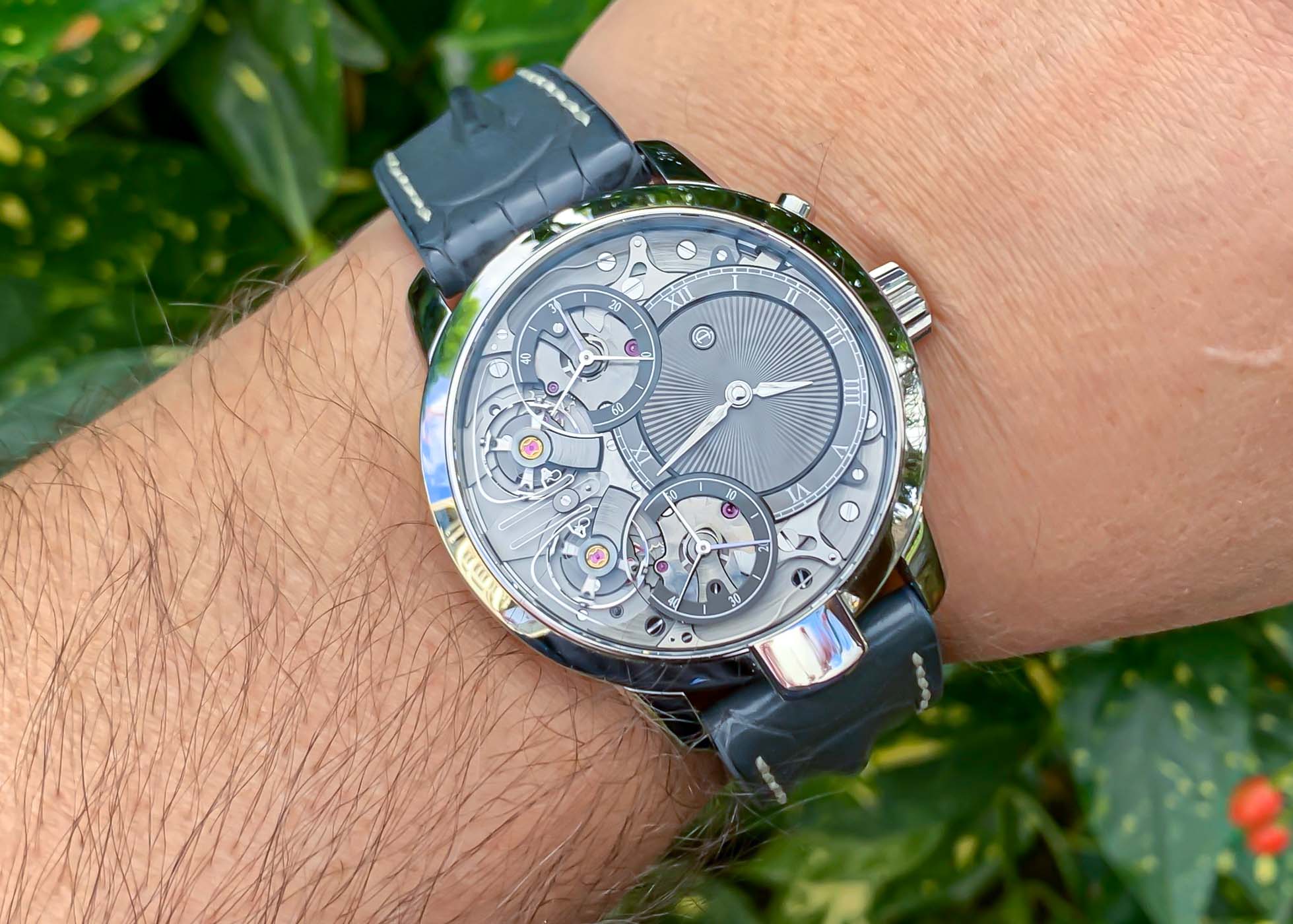


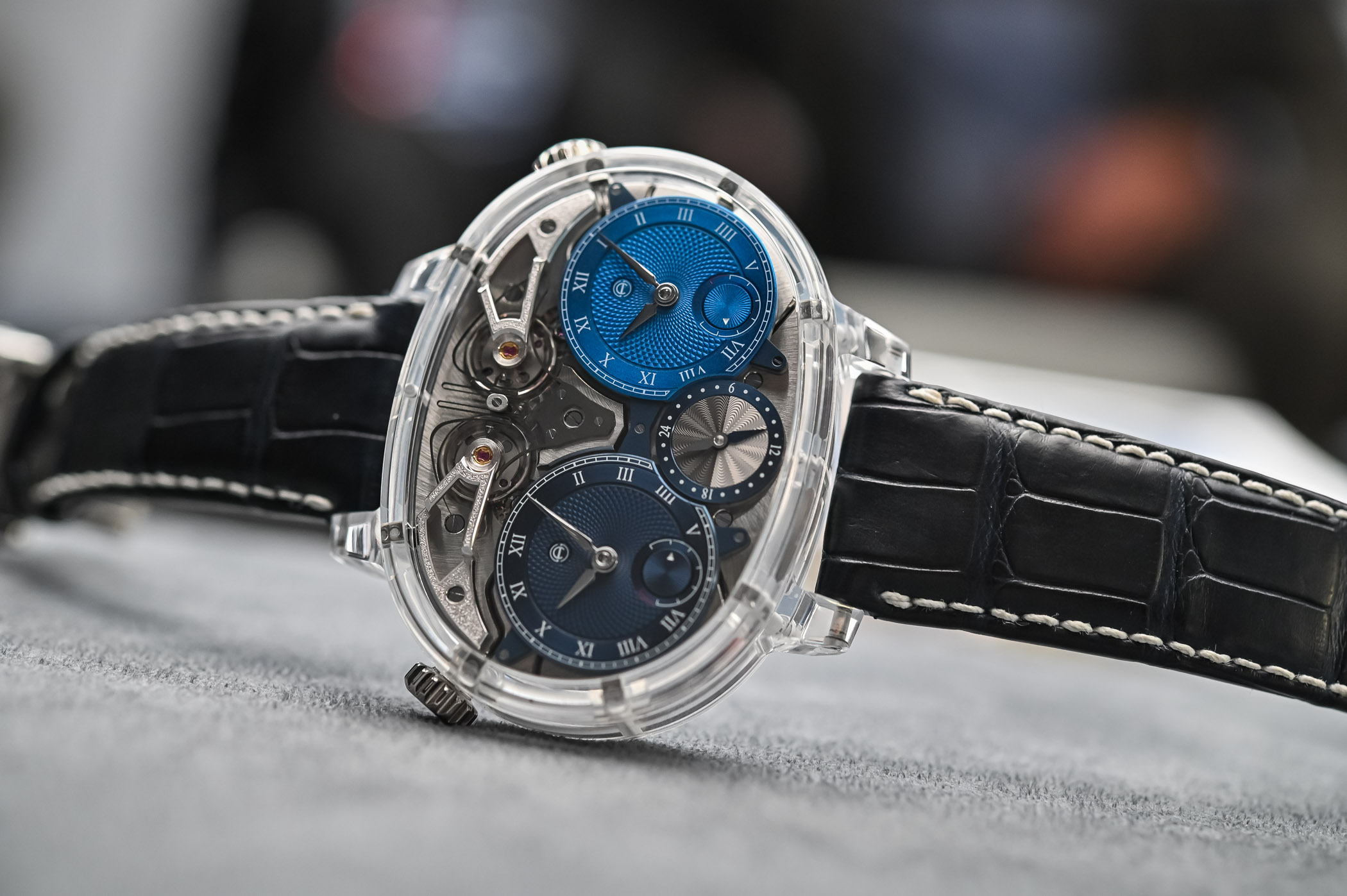
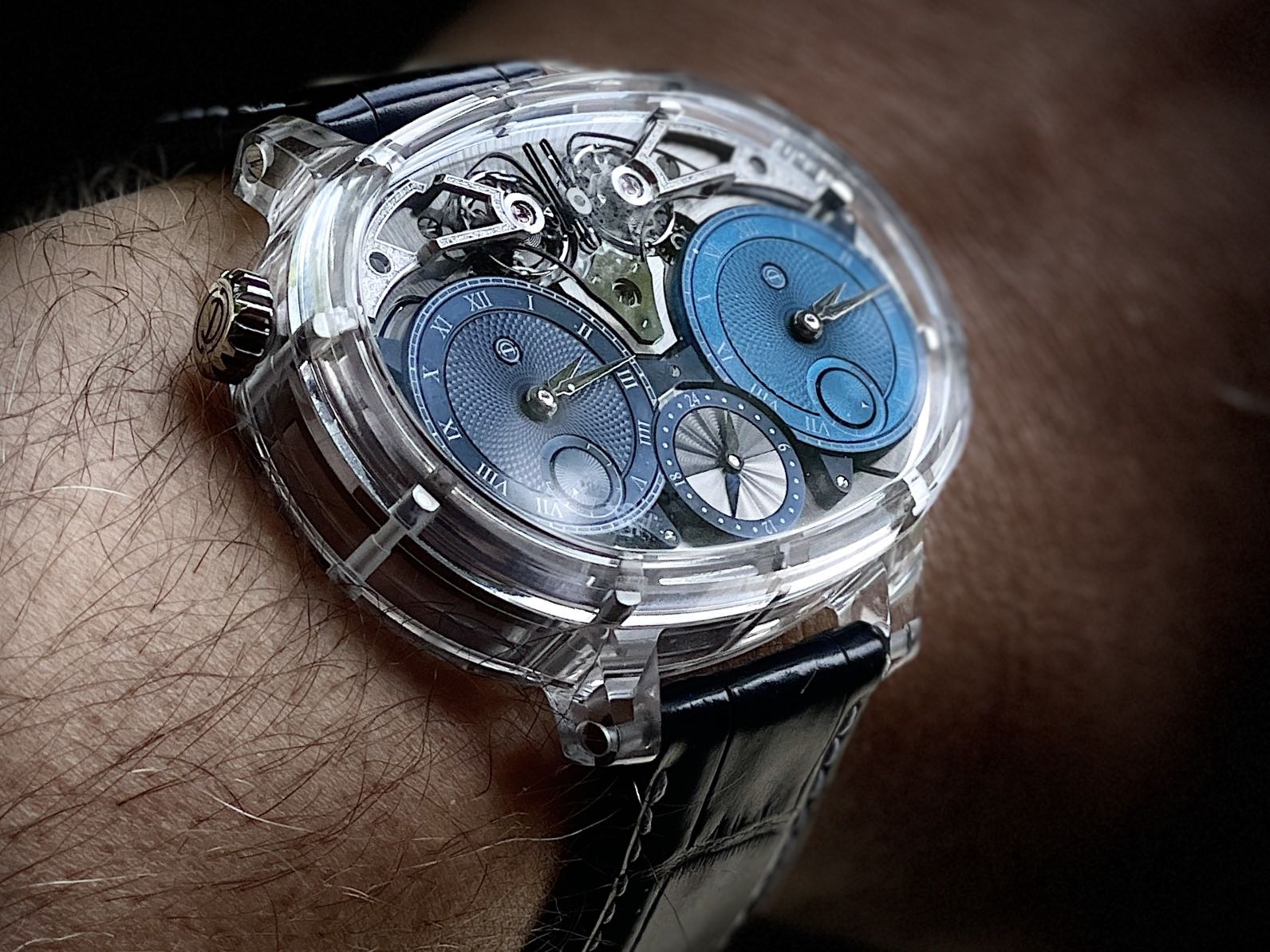
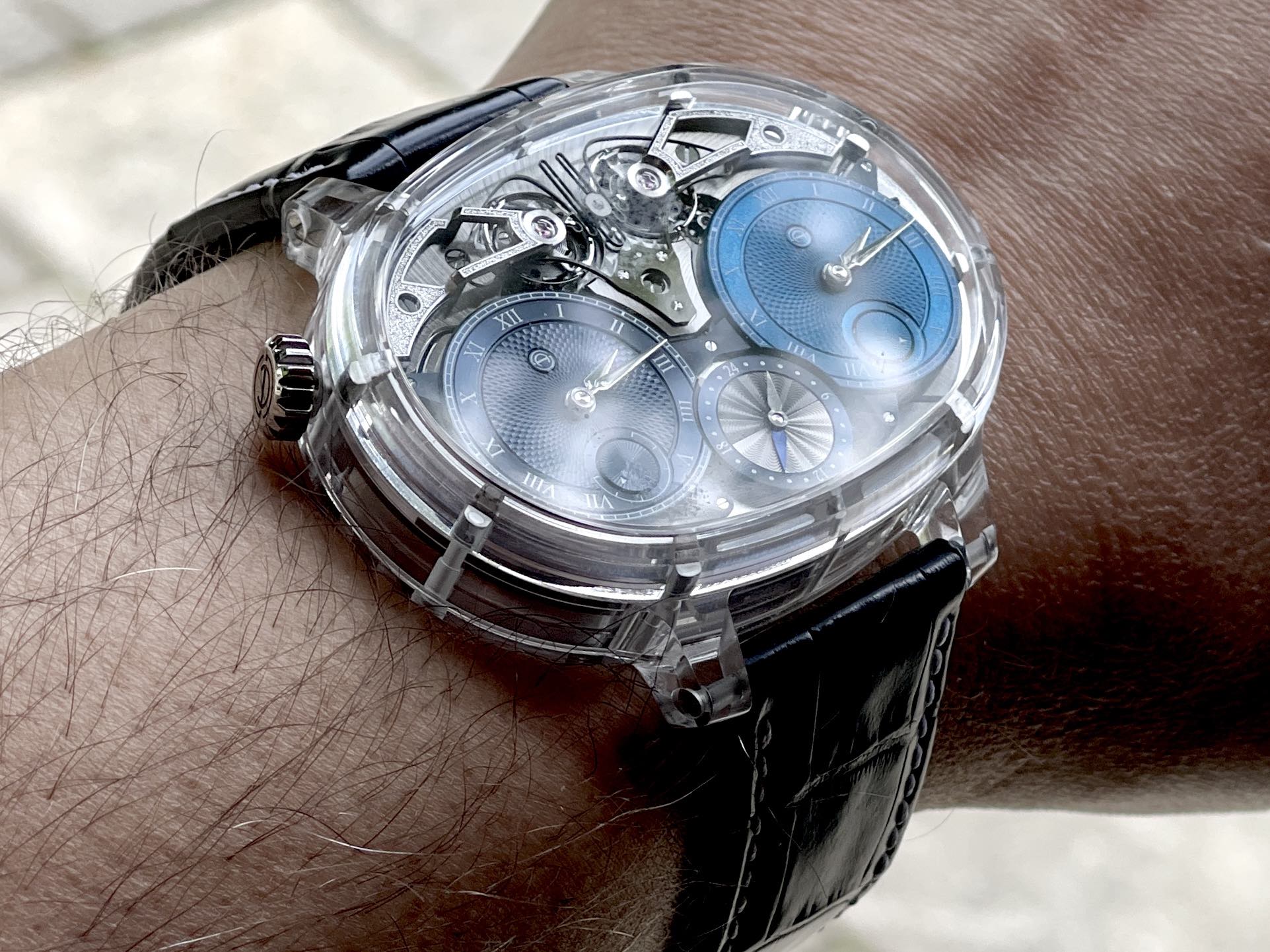

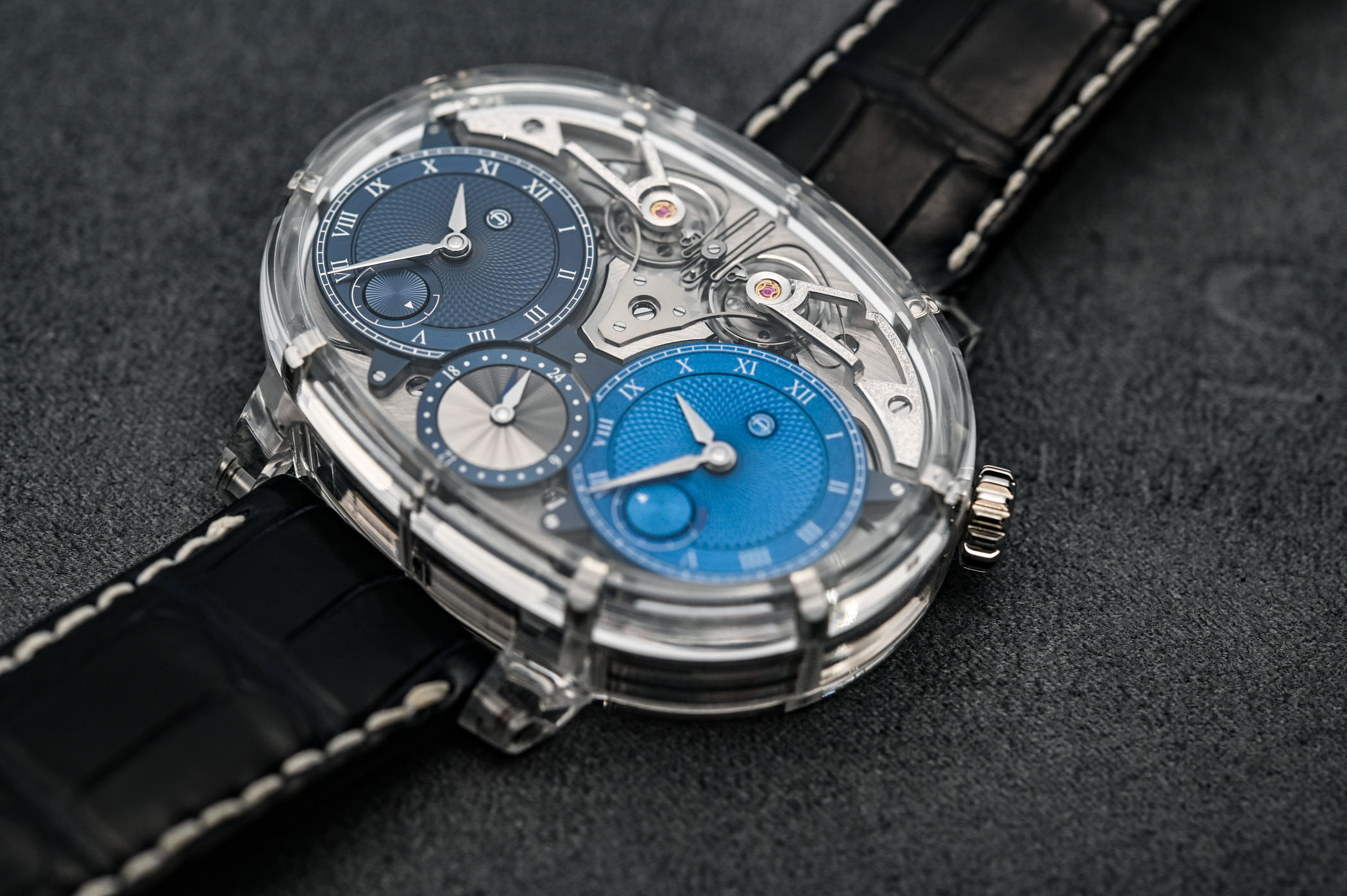
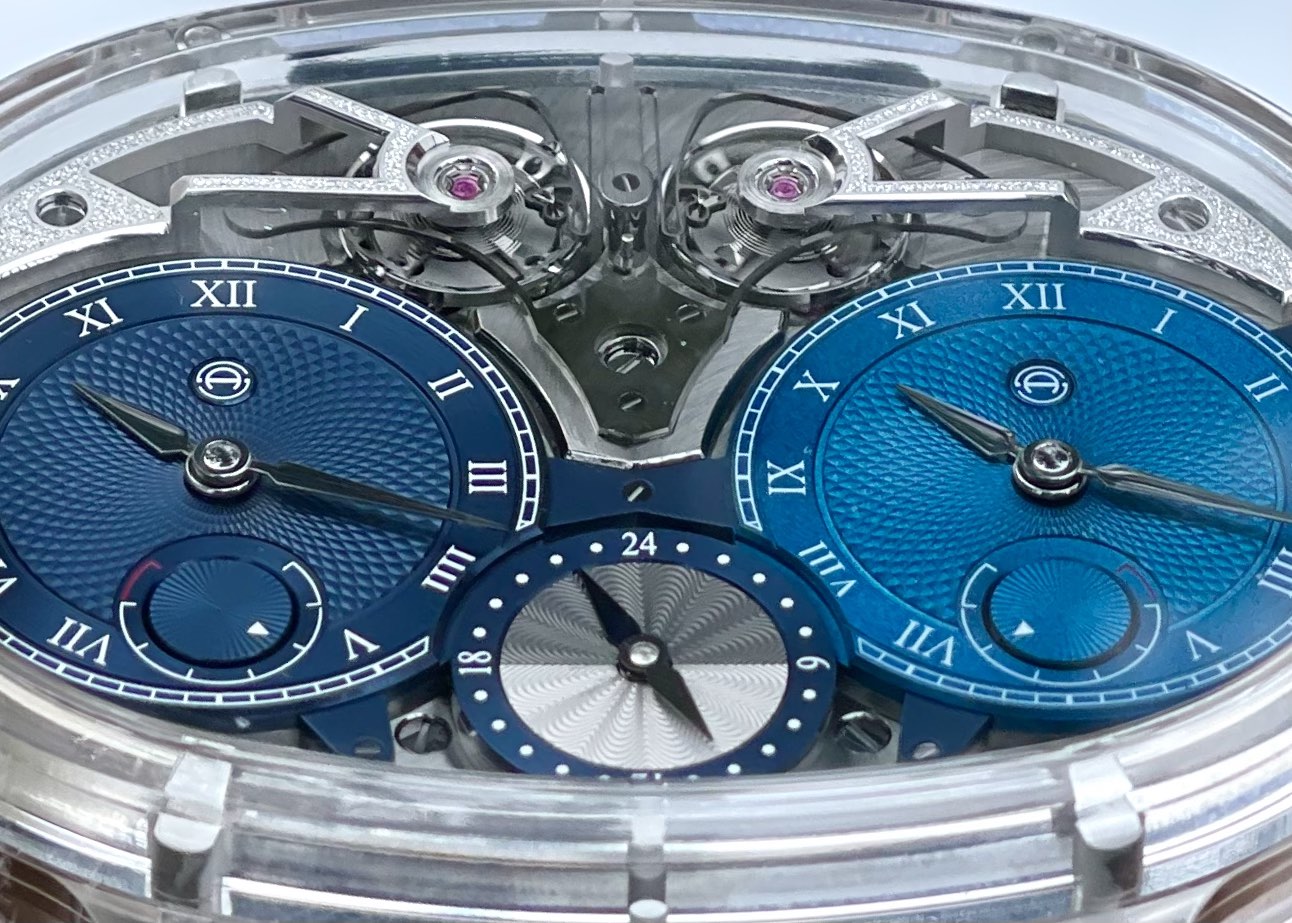
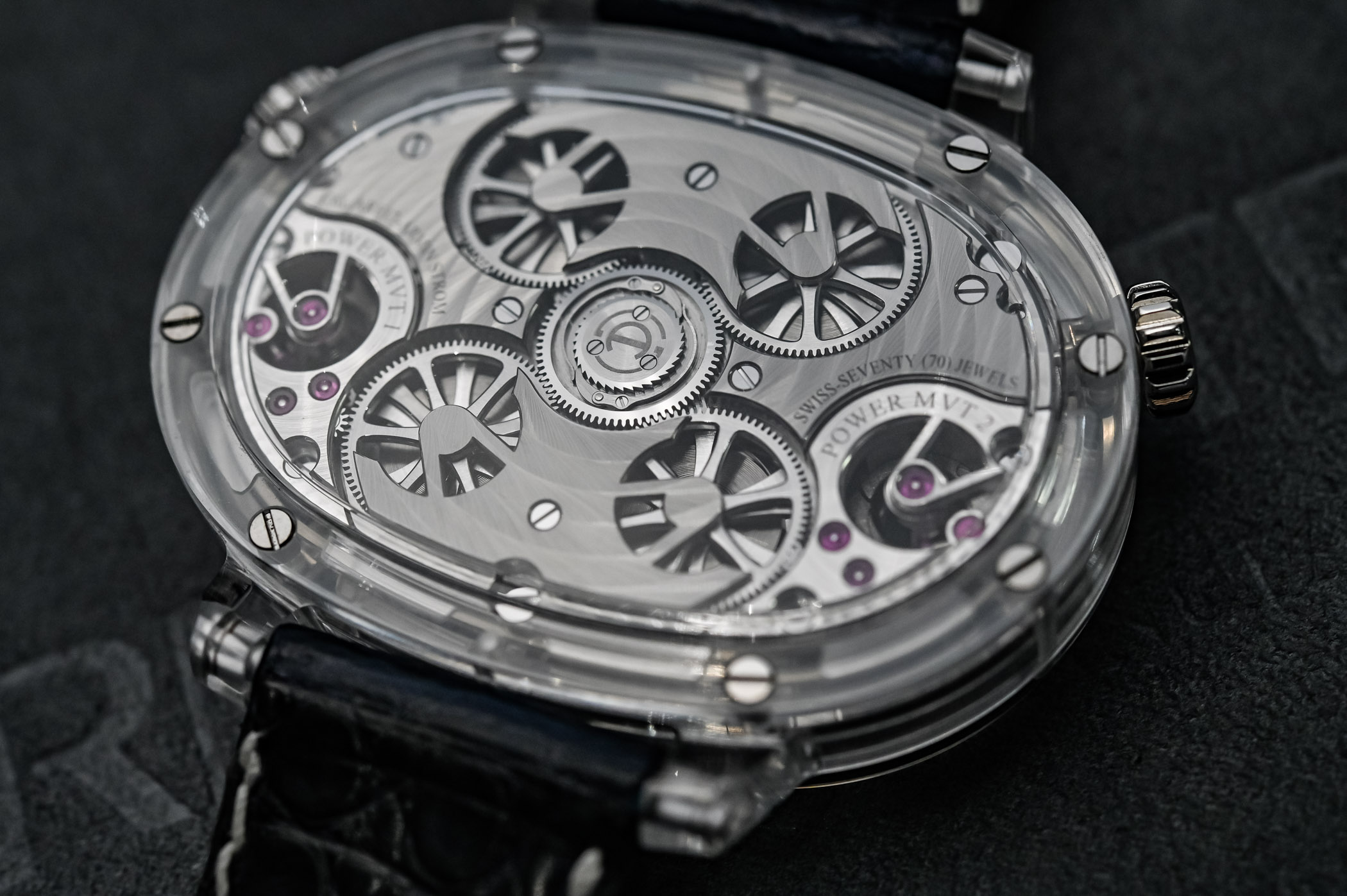


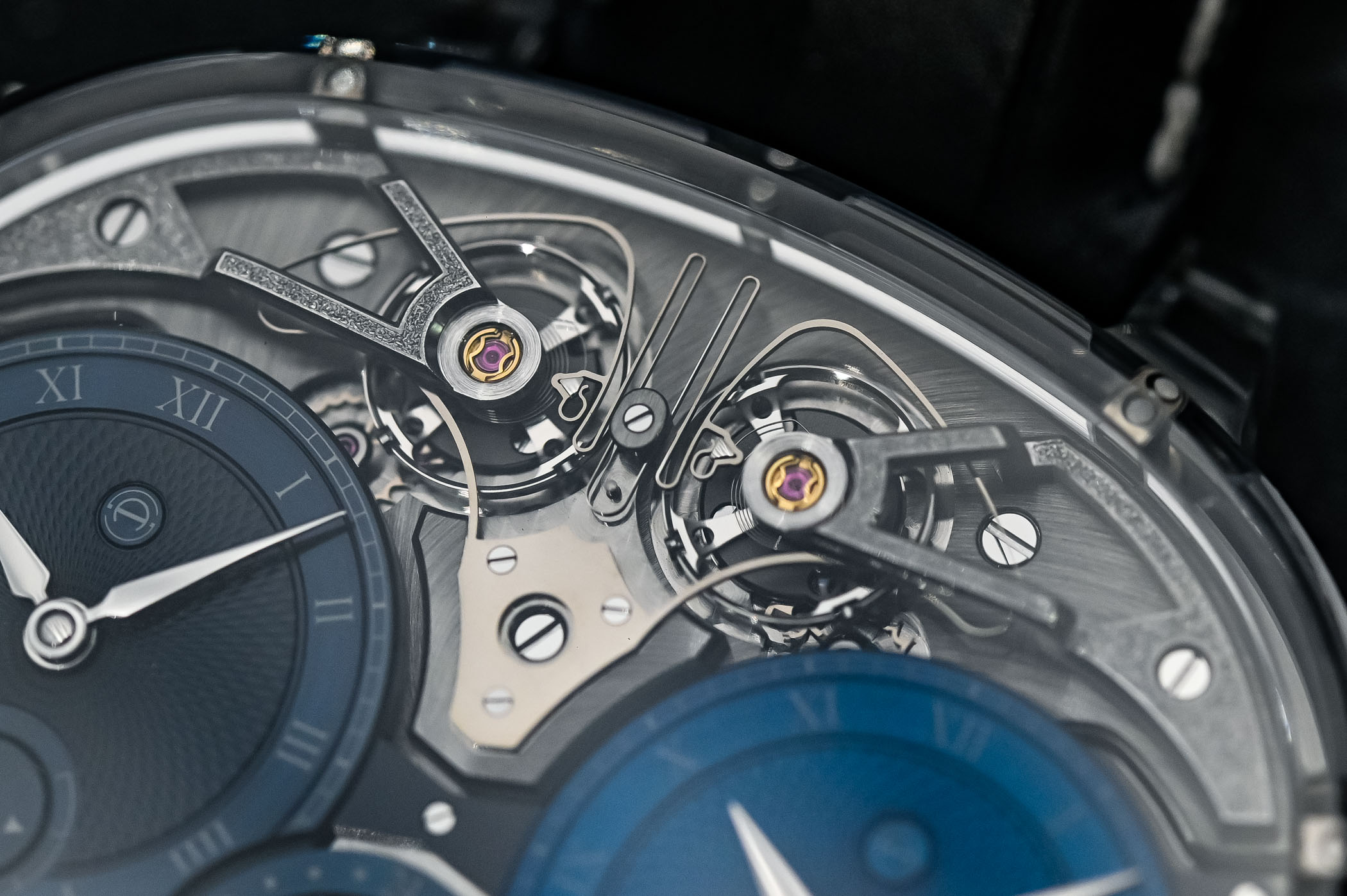
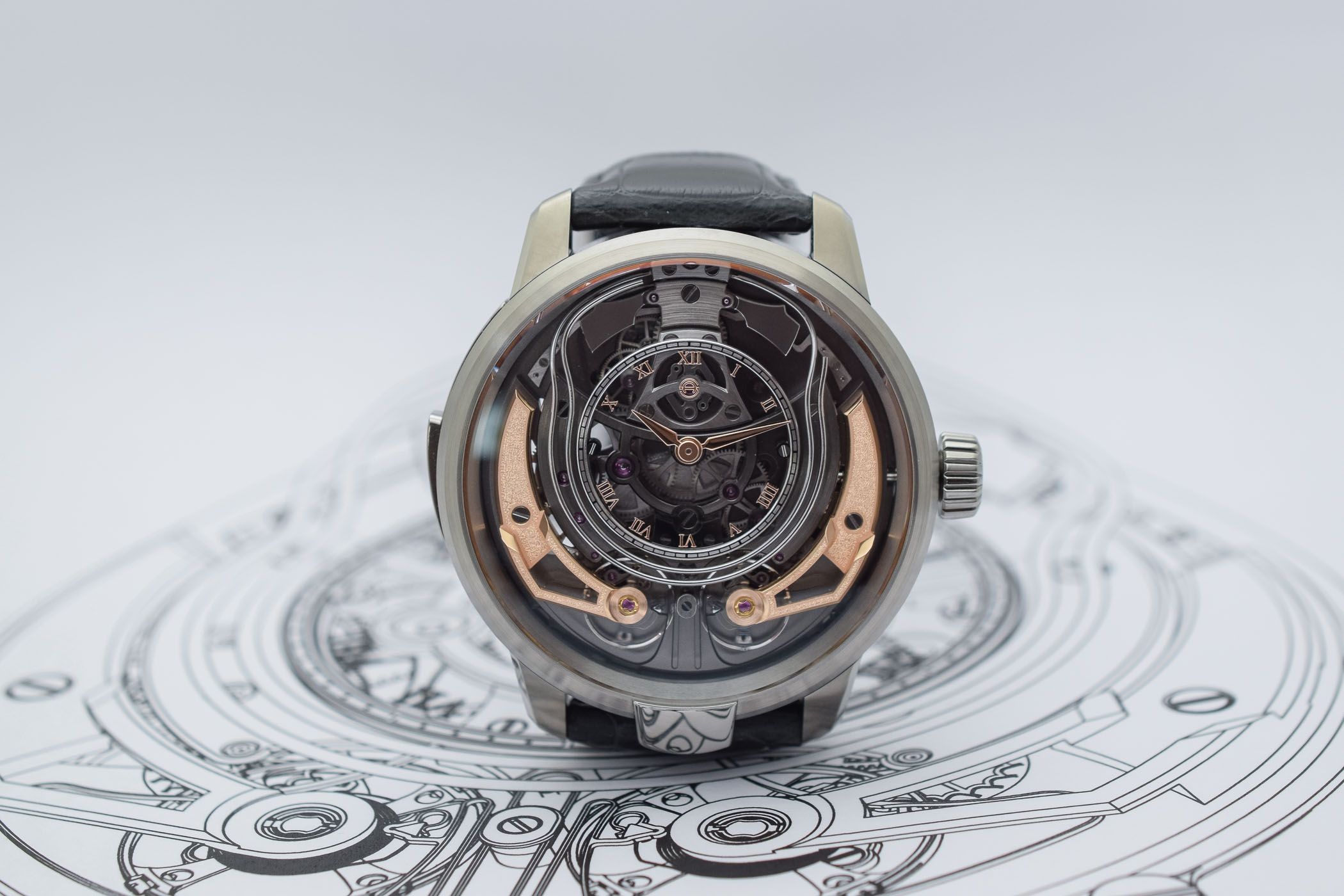



2 responses
Scale it 20 times, put 4 legs under it and it would make for an interesting coffee table.
I’d buy that too! 🤣